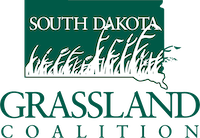Walking through Charlie Totton’s pasture in September this year is difficult. The grass is thick making me work at the task. As I walked slowly, I was trying to identify most of the plants. There were many. New clover, western wheatgrass, side oats gramma, big bluestem, little bluestem, sedges, switch grass, bluegrass, and brome were the most common. All were being grazed by the yearling heifers in the “pasture allocation” exercise at the Chamberlain Grazing School.
The most common question at the school is “What do I do about invading brome grass”? Landowners struggle with this issue from Brookings to Belle Fourche, but east river pastures are more susceptible to brome taking over the pasture. If there is one silver bullet in grazing management, it would be plant diversity. As brome grass takes over, we lose native plant diversity. When this happens, how do we get the diversity back?
One way is to increase harvest efficiency while keeping an eye on the amount of forage left for plant and soil health. The Totton Ranch is the host for the Grazing School near Chamberlain. Charlie has addressed his brome grass “problem” through a rotational grazing program. His goal is to stay in a 4-6 acre paddock with his cow herd long enough to leave 1500 lbs/acre of forage for plant and soil health. Starting with 5500 lbs/acre air dry forage, this gives us a harvest efficiency of 70%.
For Charlie, brome grass is simply one part of his multispecies pasture. His strategy is to graze the brome and bluegrass pretty hard in late April and May. Then come back through these paddocks in August. The May graze clips the brome keeping it vegetative until he comes back again. On the second time, the brome is clipped again as well as many forbs and warm season grasses growing in his pasture. The second graze on the brome keeps it from being competitive in the plant community so other species have a chance to establish themselves. The warm season grasses have a year and a few weeks to recover. The brome will be grazed again next spring or about 8 months.
Plant diversity increases the water infiltration rate. This keeps rainwater in the pasture, instead of running down the ditch. Water infiltration tests are done each year during the grazing school. In Charlie’s pasture, rainwater consistently absorbs into the soil faster on native grass than brome. It can be as significant as 15 seconds on the big bluestem to 3 minutes plus on the brome. This translates into rainwater soaking into the native mix pastures and running off the brome pastures.
Leaving 1000-1500 lbs/acre of standing forage and consuming 70% by the end of the grazing season is improving soil health and plant diversity on this East River range site. On a West River pasture, in order to leave 1000 lbs/acre of forage the harvest efficiency might be much lower. Every ranch has its own unique combination of resources.
Back to walking across Charlie’s pasture. It is obvious there is adequate litter, no bare ground between plants, and lots of diversity in forbs and grasses. Add this to great water infiltration rates and you have a healthy and productive pasture where brome grass is an asset not a problem.
Dan Rasmussen is a third-generation cattle rancher living in south central South Dakota. Dan served on the board of the South Dakota Grassland Coalition for 18 years and is currently the education coordinator for the Grassland Coalition.
